 MAMA XI 293 (Northern Lykaonia)
MAMA XI 293 (Northern Lykaonia) 
Funerary inscription of Leon, soldier
- Type of monument:
- Funerary inscription.
- Location:
- Tutup (Yazıbelen) (Northern Lykaonia): by the door of a house.
- Description:
- Grey marble column, broken above and below. Inscription laid out around an incised cross, lines 1-3 to r., lines 4-8 to l.
- Dimensions:
- Ht. 0.50+; Diameter 0.42; letters 0.030-0.065.
- Record:
- Squeeze; MB notebook copy; photographs (1956/126).
- Publication:
- None.
- Date:
- Eleventh or twelfth century AD.
ἔθα κα-
τάκη-
τε Λέον ἐ-
{Α} ιστρα-
5τιότις μινὶ
Δεκεβρί-
ου ἰς τὰ̣[ς]
κα´
Here lies Leon, soldier; (he died) in the month of December, on the 21st day.
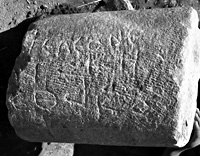
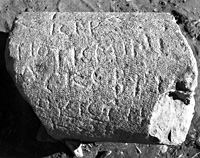
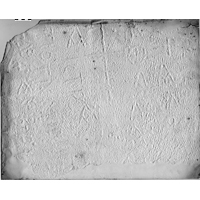
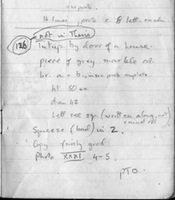
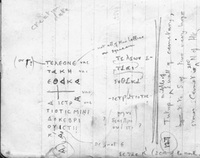



For the layout of the inscription, see the squeeze and notebook copy below. Apparently the mason began with the column standing upright, and inscribed the cross and the first three lines vertically from left to right; this would explain the 'incorrect' orientation of the three alphas in lines 1-2. At this point, he turned the column on its side (with the result that lines 1-3 now appeared to read ‘upwards’!) and inscribed lines 4-8 ‘below’ the cross. The stray alpha on its side at the start of line 4 is difficult to explain. It is perhaps most likely that it should be associated with the cross in the centre of the inscription; the mason may have intended to inscribe the letters alpha and omega flanking the cross, but in that case the absence of any sign of the omega is puzzling.
The spelling ἔθα in line 1 is paralleled in Lykaonia: cf. MAMA VIII 278 (Obruk: ἐθά[δε κατ]άκητε); Laminger-Pascher 1992: 87-8, nos. 106 and 107 (Yukarı Kaya Assar: ἔθα κατάκητε). For the iotacism εἰστρατιότις, cf. MAMA XI 45 (1954/13: Eumeneia); MAMA VII 63a (Laodikeia Katakekaumene); Swoboda, Keil and Knoll 1935: 43, no. 98 (Üstünler, south of Lake Karalis). For the means of indicating the date in lines 5-8, compare MAMA VIII 278 (Obruk: μ(η)ν(ὶ) Ἀγούστου ἠς τὰς (?) ἤκ⟨οσ⟩η); Laminger-Pascher 1992: 83, no. 92 (Madenşehir: μηνὴ Μαρτήτου ἠς τὰς δεκαπέτε); Laminger-Pascher 1992: 87-8, no. 106 (ἐκυμίθη μηνὴ Γενοαρήου ἠς τὰς τρήαντα μήαν); TAM V 2, 1158 (Thyateira, AD 1006: μηνὶ Μαήο ἠς τὰς κθ΄); Grégoire 1922: 99, no. 292 (Myra, AD 1118: μη(νὶ) Αὐγούτο εἰς τ(ὰς) ς΄); I.Ephesos 4144 ([μηνὶ Σεπ]τεμβρίῳ ἰς τὰ κ΄). This form of dating is characteristic of documents of the eleventh and twelfth centuries: see the examples collected by Dagron and Feissel 1985: 461.
The village of Tutup, now Yazıbelen, lies just north of an easy pass (Tilki Bel or Tutup Beli) over the northern Boz Dağ; the village of Eğribayat (MAMA XI 296 [1956/124]) lies on the southern side of this pass. This pass carried the main ancient road from Ikonion to Ankara (Ballance 1958: 224, 229-31). A Hadrianic milestone from this road was discovered by Ramsay at Tutup (A. M. Ramsay 1910: 26-7, no.8; French 1988: 239, no. 669). This milestone was seen again by Ballance at Tutup in 1956, ‘in the east wall of a cemetery near the main Ankara-Konya road’; the inscription was almost entirely concealed, and Ballance took neither a photograph nor a squeeze.